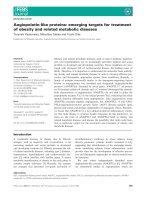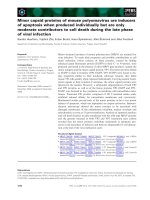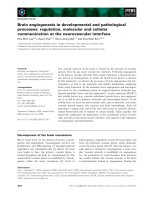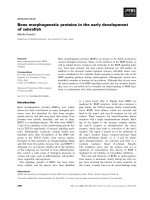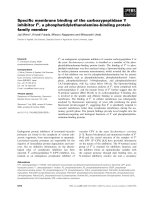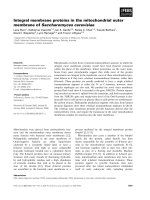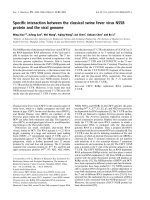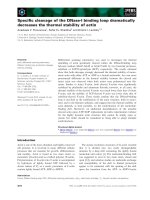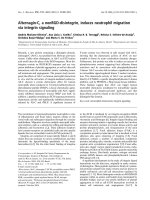Báo cáo khoa học: End-damage-specific proteins facilitate recruitment or stability of X-ray cross-complementing protein 1 at the sites of DNA single-strand break repair docx
Bạn đang xem bản rút gọn của tài liệu. Xem và tải ngay bản đầy đủ của tài liệu tại đây (454.29 KB, 11 trang )
End-damage-specific proteins facilitate recruitment or
stability of X-ray cross-complementing protein 1 at the
sites of DNA single-strand break repair
Jason L. Parsons
1
, Irina I. Dianova
1
, Emma Boswell
1
, Michael Weinfeld
2
and Grigory L. Dianov
1
1 MRC Radiation and Genome Stability Unit, Harwell, Oxon, UK
2 Cross Cancer Institute, University of Alberta, Edmonton, Alberta, Canada
DNA single-strand breaks (SSBs) arising as a result
of the disruption of phosphodiester bond linkage of
nucleotides in a polymer are dangerous, because, if left
unrepaired, they may block vital processes such as
DNA transcription and DNA replication. SSBs arise
by several distinct mechanisms including direct energy
deposition by ionizing radiation, attack by reactive
oxygen species, during enzymatic processing of endo-
genous DNA lesions, and as a result of aberrant DNA
topoisomerase I activity (reviewed in [1,2]). Many of
the SSBs arise as a consequence of loss of the DNA
base and subsequent sugar fragmentation, which
should be considered as a single nucleotide gap with
modified 5¢ and ⁄ or 3¢ ends. For example, SSBs pro-
duced by ionizing radiation or by attack from reactive
oxygen species often contain 3¢-phosphoglycolate or
3¢-phosphate groups [3]. Similarly, some radiation-
induced SSBs, as well as those arising during base
excision repair (BER), contain a 5¢-sugar phosphate
residue [4–6]. Thus, SSBs produced by several geno-
toxic agents include a variety of termini that have to
be converted into conventional 3¢-OH ⁄ 5¢-phosphate
nicks before the gap can be filled by a DNA polym-
erase and the DNA ends resealed by a DNA ligase.
Several BER enzymes have been shown to possess
‘end cleaning’ activities. The major mammalian endo-
nuclease that processes abasic sites [apurinic ⁄ apyri-
midinic endonuclease 1 (APE1)] [7] was also shown
to be the major 3¢-phosphoglycolate activity in human
cell extracts [8–11]. Human polynucleotide kinase
(PNK) is the major 3¢-phosphatase [12,13], and DNA
polymerase b (Pol b) is the major activity in human
cell extracts catalysing removal of 5 ¢ -sugar phosphate
residues [14]. Although most of the enzymes involved
in end processing have been identified and this pro-
cess plays a key role in maintaining genome stability,
the precise mechanism governing recognition and
processing of such a variety of SSBs is unclear. To
Keywords
apurinic ⁄ apyrimidinic endonuclease 1; DNA
polymerase b; DNA repair; polynucleotide
kinase; X-ray cross-complementing protein 1
Correspondence
G. L. Dianov, Radiation and Genome
Stability Unit, Medical Research Council,
Harwell, Oxfordshire OX11 0RD, UK
Fax: +44 1235 841200
Tel.: +44 1235 841134
E-mail:
(Received 6 July 2005, revised 2 September
2005, accepted 8 September 2005)
doi:10.1111/j.1742-4658.2005.04962.x
Ionizing radiation, oxidative stress and endogenous DNA-damage pro-
cessing can result in a variety of single-strand breaks with modified 5¢
and ⁄ or 3¢ ends. These are thought to be one of the most persistent
forms of DNA damage and may threaten cell survival. This study
addresses the mechanism involved in recognition and processing of
DNA strand breaks containing modified 3¢ ends. Using a DNA–protein
cross-linking assay, we followed the proteins involved in the repair of
oligonucleotide duplexes containing strand breaks with a phosphate or
phosphoglycolate group at the 3¢ end. We found that, in human whole
cell extracts, end-damage-specific proteins (apurinic ⁄ apyrimidinic endo-
nuclease 1 and polynucleotide kinase in the case of 3¢ ends containing
phosphoglycolate and phosphate, respectively) which recognize and pro-
cess 3¢-end-modified DNA strand breaks are required for efficient
recruitment of X-ray cross-complementing protein 1–DNA ligase IIIa
heterodimer to the sites of DNA repair.
Abbreviations
SSB, single-strand break; BER, base excision repair; APE1, apurinic ⁄ apyrimidinic endonuclease 1; PARP-1, poly(ADP)-ribose polymerase-1;
PNK, polynucleotide kinase; Pol b, DNA polymerase b; XRCC1, X-ray cross-complementing protein 1; WCE, whole cell extract.
FEBS Journal 272 (2005) 5753–5763 ª 2005 FEBS 5753
address the mechanism involved in DNA SSB recog-
nition and repair, we used a formaldehyde cross-
linking assay to follow the proteins involved in
processing of 3¢-end-modified DNA SSBs in human
cell extracts.
Results
Outline of cross-linking assay
We have recently developed a new DNA–protein
cross-linking protocol aimed at revealing the engage-
ment of BER proteins during repair of damaged DNA
[15]. In brief, this protocol uses oligonucleotides con-
taining a 3¢-biotinylated end which are used to form a
damage-containing and a control duplex oligonucleo-
tide complete with a hairpin loop to prevent nuclease
digestion of the oligonucleotide during incubation with
cell extracts (Fig. 1). The oligonucleotides are subse-
quently bound to streptavidin magnetic beads and
incubated with whole cell extracts (WCEs) in buffer
containing ATP, dNTPs and NAD
+
to allow repair to
proceed. After incubation for the times indicated, pro-
teins involved in repair are cross-linked to the DNA
and to each other by the addition of formaldehyde.
The beads are subsequently washed before reversal of
the cross-links, and released proteins are analysed by
gel electrophoresis and immunoblotting with the cor-
responding antibodies. We used this assay to follow
repair protein cross-linking during incubation with
human WCE for three different oligonucleotide
duplexes containing a one-nucleotide gap marked with
3¢-hydroxyl, 3¢-phosphate or 3¢-phosphoglycolate ends
in comparison with a control undamaged duplex
(Fig. 1).
XRCC1 is not essential for Pol b binding to a
gap-containing DNA
Although it is obvious that DNA SSBs containing
modified 3¢-end lesions will require specific proteins for
‘cleaning’ the ends and preparing them for DNA
repair, the time and mechanism of entry of these pro-
teins and other BER partners into the repair process is
unknown. This mechanism should include identifica-
tion of these lesions as a strand break, verification of
the nature of the 3¢ end, and identification of a satis-
factory pathway for repair. The XRCC1 component of
the XRCC1–DNA ligase IIIa heterodimer is thought
to be a protein providing such a mechanism by acting
as a nick sensor and a docking platform for formation
of a multiprotein complex capable of repairing various
strand breaks [16]. Consequently, to fulfil these func-
tions, the XRCC1–DNA ligase IIIa heterodimer
should be the first protein to bind to a variety of
strand breaks, and recruitment of other repair proteins
should depend on it. We tested this model in a direct
experiment by analysing the interdependence of BER
protein binding ⁄ cross-linking to different DNA sub-
strates.
Fig. 1. Structures of oligonucleotides used. To construct 3¢-biotinylated hairpin substrates for cross-linking, oligonucleotides were designed to
contain the complementary sequence with a TTTT hairpin loop and a 3¢-biotinylated moiety (designated *). Substrates (2–4) contain a single-
nucleotide gap with a 3¢ end containing an hydroxyl (OH), phosphate (P) or phosphoglycolate (PG) residue, respectively.
Mammalian DNA single-strand break repair J. L. Parsons et al.
5754 FEBS Journal 272 (2005) 5753–5763 ª 2005 FEBS
Two proteins are required to repair a single-nucleo-
tide gap containing substrate with a 3¢-hydroxyl end:
Pol b, which will add one nucleotide to the 3¢ end and
fill the gap, and XRCC1–DNA ligase IIIa hetero-
dimer, which will seal the DNA ends. In agreement
with this, using HeLa WCE, we were able to cross-link
these proteins to the gap-containing substrate to a
greater extent than to the control substrate (Fig. 2A),
indicating damage specificity of cross-linking. When 5¢-
labelled gap-containing oligonucleotide attached to the
beads was incubated with WCE, gap filling by Pol b
can be observed as early as 0.25–0.5 min, at a point
where substantial cross-linking of Pol b is observed,
and was nearly completed within 2 min (Fig. 2B).
Ligation was mostly accomplished between 1 and
2 min, and the XRCC1–DNA ligase IIIa heterodimer
can be efficiently cross-linked to the substrate during
this period. Approximately 80% of the repair of the
substrate is achieved within 4 min at a point where the
proteins are dissociating from the DNA. Therefore,
cross-linking of Pol b and the XRCC1–DNA ligase
IIIa heterodimer correlates well with the kinetics of
repair.
We next immunodepleted the XRCC1–DNA ligase
IIIa heterodimer from WCE using XRCC1 antibodies
and tested whether immunodepletion will affect Pol b
binding ⁄ cross-linking to the gapped DNA. As Pol b
interacts with and partially coprecipitates XRCC1,
immunodepleted extracts contained slightly less Pol b
(20%; Fig. 3A), and therefore slightly reduced (10%)
cross-linking was observed (Fig. 3B). However, we
found that, when normalized to the protein amount in
the cell extract, Pol b retained full ability to recognize
and bind a single-nucleotide gap in the absence of
XRCC1–DNA ligase IIIa (Fig. 3C), suggesting that
Pol b probably binds first, processes the gapped DNA
to the ligatable stage by filling the gap, and then
recruits XRCC1–DNA ligase IIIa heterodimer to
accomplish the repair. To test this, we immunodepleted
Pol b from WCE and monitored efficiency of
XRCC1–DNA ligase IIIa binding ⁄ cross-linking to the
gap-containing substrate. We found that, although the
amount of XRCC1 remains the same in mock or Pol
b-depleted cell extracts (Fig. 3D), cross-linking of
XRCC1 in the latter was reduced by approximately
twofold (Fig. 3E,F), indicating that Pol b is required
for efficient XRCC1–DNA ligase IIIa binding to a
one-nucleotide gap containing substrate. As Pol b pro-
cessing of a single-nucleotide gap containing the
3¢-hydroxyl end was required for efficient XRCC1–
DNA ligase IIIa binding, we speculate that all dam-
age-processing proteins bind to the SSB before
XRCC1–DNA ligase IIIa.
Processing of the modified 3¢ end is required for
efficient XRCC1–DNA ligase IIIa binding
We further explored this model in which a damage-
specific protein binds first, processes the lesion, and
then recruits the end-joining machinery. According
to this model, repair of the 3¢-phosphoglycolate
end would involve sequential processing by APE1 (the
major 3¢-phosphoglycolate activity in human cell
extracts [11]), and Pol b before XRCC1–DNA ligase
IIIa would seal the strand break. Therefore, recruit-
ment of the XRCC1–DNA ligase IIIa heterodimer
should depend on APE1. To test this model we immu-
nodepleted APE1 from HeLa WCE. The amounts of
XRCC1 and Pol b were unaffected by the immuno-
depletion protocol (Fig. 4A). Furthermore, removal of
A
B
Fig. 2. Damage-specific cross-linking of proteins involved in the
repair of a 5¢-phosphate gap substrate and the correlation with
repair kinetics. (A) A gap-containing (left panel) or the control (right
panel) biotinylated hairpin substrate was bound to magnetic strept-
avidin beads and incubated with 100 lg HeLa cell extract for the
times indicated. After being cross-linked with formaldehyde, the
beads were washed, the cross-links were reversed, and proteins
were separated by SDS ⁄ PAGE (10% gel), transferred to poly(viny-
lidene difluoride) membranes and analysed by immunoblotting with
the indicated antibodies. (B) Alternatively, a 5¢-labelled gap-contain-
ing substrate was used. After incubation with cell extract, the
beads were washed, the DNA was stripped from the beads by
heating at 90 °C for 3 min and separated on a 20% acrylamide gel
before exposure to storage phosphor screens at 4 °C and analysis
by phosphorimaging.
J. L. Parsons et al. Mammalian DNA single-strand break repair
FEBS Journal 272 (2005) 5753–5763 ª 2005 FEBS 5755
APE1 did not affect binding ⁄ cross-linking of XRCC1
to the gapped DNA substrate where Pol b, but not
APE1 processing, is required (Fig. 4B). However bind-
ing ⁄ cross-linking of XRCC1 to the 3¢-phosphoglyco-
late-containing substrate was approximately twofold
reduced in APE1-immunodepleted but not mock-
immunodepleted cell extracts (Fig. 4C,D). To demon-
strate that deficient XRCC1 cross-linking was
exclusively due to the immunodepletion of APE1, we
complemented depleted cell extracts with purified
recombinant human APE1 which stimulated XRCC1
binding ⁄ cross-linking (Fig. 4E). Taken together these
experiments indicate that APE1 is required for efficient
XRCC1–DNA ligase IIIa heterodimer binding to the
3¢-phosphoglycolate-containing substrate.
In a similar set of experiments, we immunodepleted
PNK and investigated cross-linking of XRCC1 and
PNK to a 3¢-phosphate-containing substrate. Immuno-
depletion of PNK notably reduced the 3¢-phosphatase
activity of cell extracts (Fig. 5A) and further demon-
strates that PNK is the major 3¢-phosphate-processing
activity in human cell extracts as previously described
[13]. Furthermore, immunodepletion of PNK did not
affect the amounts of XRCC1 and Pol b in the extract
(Fig. 5B). Using the same extract, we found efficient
cross-linking of XRCC1 to the 3¢-OH gapped substrate
(Fig. 5C) for which no processing by PNK but only
processing by Pol b, which remains in the immuno-
depleted extract, is required. Using these extracts,
we were able to efficiently cross-link both XRCC1
AB
CD
E
F
Fig. 3. XRCC1–DNA ligase IIIa heterodimer
is not essential for Pol b binding to a single-
nucleotide gap-containing substrate. Western
blot analysis of WCE, mock immunodepleted
(Mock) and XRCC1 (A) or Pol b (D) immuno-
depleted cell extracts (ID) with XRCC1 and
Pol b antibodies. A gap-containing or the con-
trol biotinylated hairpin substrate was bound
to magnetic streptavidin beads and incubated
with 100 lg HeLa mock immunodepleted cell
extract, XRCC1 or Pol b immunodepleted
HeLa cell extract (B and E, respectively) for
the times indicated and cross-linked with for-
maldehyde. The beads were subsequently
washed, the cross-links were reversed, and
proteins were separated by SDS ⁄ PAGE
(10% gel), transferred to poly(vinylidene diflu-
oride) membranes, and analysed by immuno-
blotting with the indicated antibodies. The
total amounts of Pol b (C) or XRCC1 (F) cross-
linked throughout the time course using the
XRCC1 and Pol b immunodepleted HeLa cell
extract, respectively, were quantified from
three independent experiments by densito-
metry.
Mammalian DNA single-strand break repair J. L. Parsons et al.
5756 FEBS Journal 272 (2005) 5753–5763 ª 2005 FEBS
and PNK in mock-immunodepleted cell extracts, but
a threefold reduction in XRCC1 cross-linking was
observed using the PNK-depleted cell extracts
(Fig. 5D,E), even though the two extracts contained
equal amounts of XRCC1. Finally, addition of purified
human PNK to the PNK-immunodepleted cell extracts
stimulated XRCC1 cross-linking (Fig. 5F). These
experiments suggest that XRCC1–DNA ligase IIIa het-
erodimer would not efficiently bind to the 3¢-phos-
phate-containing substrate before removal of the
phosphate group by PNK. Although immunodepletion
of XRCC1–DNA ligase IIIa heterodimer reduced the
level of endogenous PNK (data not shown), when
PNK was brought to the mock immunodepletion level
by addition of the recombinant human protein, it was
efficiently cross-linked to the 3¢-phosphate-containing
substrate in XRCC1-depleted extracts (data not
shown), indicating that, as in the case of Pol b, PNK
binding is not dependent on XRCC1–DNA ligase IIIa
heterodimer.
Interaction between PNK and XRCC1 is required
for effective XRCC1–DNA ligase IIIa recruitment
to the site of DNA damage
PNK interacts with the phosphorylated form of
XRCC1–DNA ligase IIIa through its FHA domain,
and a mutation (R35A) in this domain disrupts this
A
DE
B
C
Fig. 4. APE1 is required for efficient XRCC1–DNA ligase IIIa binding to a 3¢-end phosphoglycolate-containing substrate. Western blot analysis
of WCE, mock immunodepleted (Mock) and APE1-immunodepleted HeLa cell extract (ID) with the indicated antibodies (A). A 3¢-end hydro-
xyl-containing substrate (B) or a 3¢-end phosphoglycolate-containing substrate (C and E) bound to magnetic streptavidin beads was incubated
with 100 lg mock immunodepleted, APE1-immunodepleted or APE1-immunodepleted extract complemented with 30 ng APE1 (E, last two
lanes) for the times indicated and cross-linked with formaldehyde. The beads were subsequently washed, the cross-links were reversed,
and proteins were separated by SDS ⁄ PAGE (10% gel), transferred to poly(vinylidene difluoride) membranes, and analysed by immunoblotting
with the indicated antibodies. The total amounts of XRCC1 cross-linked throughout the time course using the 3¢-end phosphoglycolate-
containing substrate were quantified from three independent experiments by densitometry (D).
J. L. Parsons et al. Mammalian DNA single-strand break repair
FEBS Journal 272 (2005) 5753–5763 ª 2005 FEBS 5757
interaction [17]. Using site-directed mutagenesis, we
generated the R35A PNK mutant and demonstrate that
it is deficient in its interaction with XRCC1 compared
with the wild-type protein (Fig. 6A). However, the
mutant retains full 3¢-phosphatase activity (Fig. 6B).
Using the cross-linking assay, we demonstrate that
A
B
D
EF
C
Fig. 5. PNK is required for efficient XRCC1–DNA ligase IIIa binding to a 3¢-end phosphate-containing substrate. A 5¢-labelled oligonucleotide
substrate containing a 3¢-phosphate gap was incubated with mock immunodepleted or PNK-immunodepleted HeLa cell extract (0–5 lg) for
20 min before the addition of formamide loading dye, and the DNA separated on a 6% acrylamide gel and analysed by phosphorimaging (A).
Western blot analysis of WCE, mock immunodepleted (Mock) and PNK-immunodepleted cell extracts (ID) with the indicated antibodies (B).
A3¢-end phosphate-containing substrate (D and F) or a 3¢-end hydroxyl-containing substrate (C) bound to magnetic streptavidin beads was
incubated with 100 lg mock immunodepleted or PNK-immunodepleted HeLa cell extract or PNK-immunodepleted extract complemented
with 20 ng PNK (F, last two lanes) for the times indicated and cross-linked with formaldehyde. The beads were subsequently washed, the
cross-links were reversed, and proteins were separated by SDS ⁄ PAGE (10% gel), transferred to poly(vinylidene difluoride) membranes, and
analysed by immunoblotting with the indicated antibodies. The total amounts of XRCC1 cross-linked throughout the time course using the
3¢-end phosphate-containing substrate were quantified from three independent experiments by densitometry (E).
Mammalian DNA single-strand break repair J. L. Parsons et al.
5758 FEBS Journal 272 (2005) 5753–5763 ª 2005 FEBS
the complementation of PNK-depleted cell extracts
with wild-type PNK restores XRCC1–DNA ligase IIIa
heterodimer binding ⁄ cross-linking (Fig. 6C). However,
complementation with the R35A PNK mutant has very
little effect on XRCC1–DNA ligase IIIa heterodimer
binding ⁄ cross-linking (Fig. 6C), indicating that inter-
action between PNK and XRCC1 is important
for recruitment of XRCC1–DNA ligase IIIa hetero-
dimer.
Discussion
Poly(ADP)-ribose polymerase-1 (PARP-1) has a very
high affinity for strand breaks and binds them before
any other repair proteins [18]. Binding of PARP-1 to
the SSB stimulates formation of poly(ADP)-ribose
polymers and dissociation of PARP-1 from the DNA
[19]. A recent study from our group showed that
PARP-1 is always involved in BER of DNA base
lesions and SSBs and is important for preventing deg-
radation of excessive SSBs by cellular nucleases as
previously proposed [20]. Blocking of poly(ADP)-
ribosylation and consequent dissociation of PARP-1
from SSB results in inhibition of SSB repair and repair
foci formation [18,21]. However, when there are suffi-
cient amounts of repair enzymes present, they effi-
ciently substitute PARP-1 from the nicked DNA [18].
Therefore, when repair enzymes are in excess over the
amount of DNA SSBs, neither the cross-linking effi-
ciency of XRCC1–DNA ligase IIIa heterodimer and
Pol b nor the rate of repair are affected in PARP-1-
deficient cells [22,23], suggesting that in this situation
PARP-1 is not essential for recruitment of other BER
proteins. That is why XRCC1–DNA ligase IIIa het-
erodimer plays a central role in the current models for
SSB repair. As XRCC1–DNA ligase IIIa heterodimer
interacts with APE1 [24], Pol b [25] and PNK [26] it
was proposed that XRCC1 serves as a docking plat-
B
A
C
Fig. 6. Interaction between PNK and XRCC1 is required for efficient XRCC1–DNA ligase IIIa binding to a 3¢-end phosphate-containing sub-
strate. (A) Pull-down of XRCC1 from WCE by His-tagged wild-type (WT) or R35A mutant PNK was performed as described in Experimental
procedures. (B) The activities of wild-type and R35A mutant PNK were analysed by incubation for 20 min with a 3¢ -end phosphate-containing
substrate followed by the addition of formamide loading dye. The DNA was separated on a 6% acrylamide gel and analysed by phosphor-
imaging. (C) A 3¢-end phosphate-containing substrate bound to magnetic streptavidin beads was incubated with 100 lg PNK-immunodeplet-
ed HeLa cell extract or PNK-immunodepleted extract complemented with 20 ng wild-type or R35A mutant PNK for the times indicated and
cross-linked with formaldehyde. The beads were subsequently washed, the cross-links were reversed, and proteins were separated by
SDS ⁄ PAGE (10% gel), transferred to poly(vinylidene difluoride) membranes, and analysed by immunoblotting with the indicated antibodies.
J. L. Parsons et al. Mammalian DNA single-strand break repair
FEBS Journal 272 (2005) 5753–5763 ª 2005 FEBS 5759
form to accommodate proteins required for repair of
SSBs [1]. It was further suggested that XRCC1–DNA
ligase IIIa heterodimer nucleates assembly of the
‘multitask’ repair complex that would be able to repair
SSBs of any complexity [16], although some data indi-
cates that efficient recruitment ⁄ stability of PNK or
Pol b at sites of SSB repair in cells would involve not
only interaction with XRCC1, but also the recognition
of the DNA substrate by PNK ⁄ Pol b [26].
Using cell extracts immunodepleted of individual
BER proteins and monitoring binding ⁄ cross-linking of
the remaining proteins to the substrate DNA, contain-
ing SSBs with various 3¢-end modifications, we investi-
gated which proteins initiate recognition and repair
of such lesions. We found that, after PARP-1 bind-
ing ⁄ dissociation, repair of the SSBs is always followed
by a specific protein that is required to progress the
particular lesion to the next stage of repair. Therefore,
Pol b initiates repair of single-nucleotide gaps, PNK is
required for the initiation of repair of 3 ¢-phosphate-
containing SSBs, and APE1 initiates repair of 3¢-phos-
phoglycolate-containing SSBs. Removal of these
proteins by immunodepletion extensively decreased
binding ⁄ cross-linking of XRCC1–DNA ligase IIIa het-
erodimer to the corresponding substrates. However,
removal of Pol b had a less pronounced effect, because
to a certain extent XRCC1 is able, although less effi-
ciently than in the presence of Pol b, to bind gapped
DNA with 3¢-hydroxyl and 5¢-phosphate ends because
it resembles nicked DNA [27]. We have also recently
demonstrated that Pol b stimulates binding ⁄ cross-
linking of XRCC1–DNA ligase IIIa heterodimer during
the repair of incised AP sites that are intermediates of
BER [28]. Conversely, immunodepletion of XRCC1–
DNA ligase IIIa heterodimer had little or no effect on
the amount of binding ⁄ cross-linking of the damage-
specific proteins required for repair initiation. Taken
together, our data do not support the model in which
XRCC1–DNA ligase IIIa heterodimer binding follows
PARP-1. Alternatively, they support the idea that
damage-specific proteins bind before XRCC1–DNA li-
gase IIIa and direct repair via a pathway that will
include only a subset of proteins required for specific
SSB processing.
On the basis of our findings, we propose a model in
which any of the BER proteins mentioned in this study
(APE1, PNK, Pol b and XRCC1–DNA ligase IIIa)
are able to independently initiate the repair process by
binding to the corresponding DNA lesion (3¢-phospho-
glycolate, 3¢-phosphate, single-nucleotide gap and SSBs
containing 3¢-hydroxyl and 5¢-phosphate groups,
respectively; Fig. 7). After initiation, repair may pro-
ceed either by the ‘passing the baton’ mechanism by
handing the substrate to the next enzyme required
[29,30] or by nucleation of a transient damage-specific
complex including a subset of enzymes that are
required for repair of a particular lesion. Our data do
not provide strong evidence in favour of transient
complexes (although we can see simultaneous cross-
linking of several repair proteins on damaged DNA).
Fig. 7. A model for mammalian DNA SSB
repair. Repair of frank strand breaks contain-
ing 3¢-hydroxyl and 5¢-phosphate groups is
accomplished by XRCC1–DNA ligase IIIa
complex (pathway A). However, a single-
nucleotide gap-containing strand break with
3¢-hydroxyl and 5¢-phosphate or 3¢-hydroxyl
and 5¢-deoxyribose phosphate is recognized
by Pol b, which fills the gap, removes the
5¢-deoxyribose phosphate and recruits
XRCC1–DNA ligase IIIa complex to seal the
DNA ends (pathway B). Strand breaks con-
taining modified 3¢ ends are recognized by
the corresponding damage-specific protein
(DSP) which converts the modified 3¢ ends
into conventional 3¢-hydroxyl ends and fur-
ther recruits Pol b and XRCC1–DNA ligase
IIIa to accomplish repair. Among the known
DSPs are APE1 and PNK which recognize
and process 3¢ ends containing phosphogly-
colate and phosphate groups, respectively.
Mammalian DNA single-strand break repair J. L. Parsons et al.
5760 FEBS Journal 272 (2005) 5753–5763 ª 2005 FEBS
However, the formation of nuclear foci by BER pro-
teins supports this model [31,32]. It is quite clear that
the lifetime of transient repair complexes, and there-
fore their lifetime within DNA damage foci, depends
on multiple interactions between the proteins involved.
XRCC1 protein, which is involved in multiple interac-
tions with other BER proteins, may play an essential
role in assembly and stability of such complexes.
Therefore, as recently reported, disruption of the inter-
action of XRCC1 with PNK or Pol b leads to defici-
ency in accumulation of PNK and Pol b in nuclear
foci induced by hydrogen peroxide [17,32] and
increased sensitivity of deficient cells to DNA damage
[33]. These data indicate that the mechanism involved
in SSB repair in living cells may be more sophisticated
than in cell extracts.
In summary, our data support the idea that BER
enzymes participate in the repair of various SSBs
through participation in multiple repair pathways ⁄
complexes involving distinct subsets of repair proteins.
For example, strand breaks containing 3¢-phosphate
ends would be initiated by PNK, followed by Pol b and
XRCC1–DNA ligase IIIa heterodimer, or alternatively,
binding of PNK would initiate formation of a transient
DNA repair complex containing all three enzymes
required for repair of this substrate. However, the
detailed molecular mechanism of repair events after
strand break binding by end-damage-specific protein is
unclear and requires further investigation.
Experimental procedures
Materials
Synthetic oligodeoxyribonucleotides were purchased from
Eurogentec (Seraing, Belgium) and purified by electrophor-
esis on a 20% polyacrylamide gel. [
32
P]ATP[cP] (3000 CiÆ
mmol
)1
) was purchased from PerkinElmer Life Sciences
(Boston, MA, USA). XRCC1 (ab144) and DNA ligase III
(ab587) antibodies were purchased from Abcam Ltd (Cam-
bridge, UK). Antibodies against rat Pol b, human APE1
and human PNK were raised in rabbit and affinity purified
as described [34]. His-tagged PNK and R35A PNK gener-
ated by site-directed PCR mutagenesis were purified on a
nickel chelating resin (Novagen, Madison, WI, USA) as
recommended by the manufacturer.
Cells
HeLa cell pellets were purchased from Paragon (Aspen, CO,
USA). WCEs were prepared by the method of Manley et al.
[35] and dialysed overnight against buffer containing 25 mm
Hepes ⁄ KOH, pH 7.9, 100 mm KCl, 12 mm MgCl
2
, 0.1 mm
EDTA, 17% glycerol and 2 mm dithiothreitol. Extracts were
divided into aliquots and stored at )80 °C.
Immunodepletion of WCEs and western blots
Immunodepletion of WCEs was performed as described [36]
and verified by SDS ⁄ PAGE (10% gel). Proteins were trans-
ferred to poly(vinylidene difluoride) membranes and immu-
noblotted using the corresponding antibodies. Blots were
visualized using the ECL plus system (Amersham, Chalfont
St Giles, Bucks, UK).
Cross-linking assay
The cross-linking assay with hairpin oligonucleotide sub-
strates attached to streptavidin magnetic beads was per-
formed as described [18]. For direct comparison, proteins
cross-linked from different substrates or extracts were ana-
lysed on the same immunoblot.
Repair assays
Repair assays of hairpin oligonucleotide substrates attached
to streptavidin magnetic beads were performed as described
previously [18].
Pull-down assay
To analyse the interactions of PNK and R35A PNK with
XRCC1, the protocol described by Caldecott et al. [37] was
followed with modifications. Briefly, 50 lg HeLa WCE was
incubated with 1 lg His-tagged PNK ⁄ R35A PNK in 40 lL
buffer A (50 mm Tris ⁄ HCl, pH 8, 0.1 m NaCl, 2% glycerol,
1mm dithiothreitol, 25 mm imidazole, pH 7.5) for 30 min
at room temperature, and then 160 lL buffer A and a
25 lL bed volume of nitrilotriacetate ⁄ agarose (Novagen)
was added. Reactions were incubated on ice with frequent
gentle mixing, and after 20 min the nitrilotriacetate ⁄ agarose
was gently pelleted by brief centrifugation. The supernatant
was removed, and the nitrilotriacetate ⁄ agarose beads
washed with 3 · 190 lL buffer A. After the final wash, the
beads were boiled in 60 lL SDS ⁄ PAGE sample buffer
[25 mm Tris ⁄ HCl, pH 6.8, 2.5% (v ⁄ v) 2-mercaptoethanol,
1% (v ⁄ v) SDS, 5% (v ⁄ v) glycerol, 1 mm EDTA,
0.15 mgÆmL
)1
bromophenol blue], and 20 lL loaded on to
an SDS ⁄ 10% polyacrylamide gel. Proteins were transferred
to a poly(vinylidene difluoride) membrane and immuno-
blotted with the corresponding antibodies.
Acknowledgements
We thank Dr Keith Caldecott for critical reading of
the manuscript and for communicating his data before
publication.
J. L. Parsons et al. Mammalian DNA single-strand break repair
FEBS Journal 272 (2005) 5753–5763 ª 2005 FEBS 5761
References
1 Caldecott KW (2001) Mammalian DNA single-strand
break repair: an X-ra(y)ted affair. Bioessays 23, 447–
455.
2 Wallace SS (1988) Detection and repair of DNA base
damages produced by ionizing radiation. Environ Mol
Mutagen 12, 431–477.
3 Ward JF (2000) Complexity of damage produced by
ionizing radiation. Cold Spring Harbor Symp Quant Biol
65, 377–382.
4 Lennartz M, Coquerelle T, Bopp A & Hagen U (1975)
Oxygen: effect on strand breaks and specific end-groups
in DNA of irradiated thymocytes. Int J Radiat Biol
Relat Stud Phys Chem Med 27, 577–587.
5 Coquerelle T, Bopp A, Kessler B & Hagen U (1973)
Strand breaks and K¢ end-groups in DNA of irradiated
thymocytes. Int J Radiat Biol Relat Stud Phys Chem
Med 24, 397–404.
6 Lindahl T & Wood RD (1999) Quality control by DNA
repair. Science 286, 1897–1905.
7 Fung H & Demple B (2005) A vital role for Ape1 ⁄ Ref1
protein in repairing spontaneous DNA damage in
human cells. Mol Cell 17, 463–470.
8 Chaudhry MA, Dedon PC, Wilson DM, Demple B &
Weinfeld M (1999) Removal by human apurinic ⁄ apyri-
midinic endonuclease 1 (Ape 1) and Escherichia coli
exonuclease III of 3¢-phosphoglycolates from DNA trea-
ted with neocarzinostatin, calicheamicin, and gamma-
radiation. Biochem Pharmacol 57, 531–538.
9 Suh D, Wilson DM & 3rd and Povirk LF (1997)
3¢-phosphodiesterase activity of human apurinic ⁄ apyri-
midinic endonuclease at DNA double-strand break
ends. Nucleic Acids Res 25, 2495–2500.
10 Winters TA, Henner WD, Russell PS, McCullough A &
Jorgensen TJ (1994) Removal of 3¢-phosphoglycolate
from DNA strand-break damage in an oligonucleotide
substrate by recombinant human apurinic ⁄ apyrimidinic
endonuclease 1. Nucleic Acids Res 22, 1866–1873.
11 Parsons JL, Dianova II & Dianov GL (2004) APE1 is
the major 3¢-phosphoglycolate activity in human cell
extracts. Nucleic Acids Res 32, 3531–3536.
12 Rasouli-Nia A, Karimi-Busheri F & Weinfeld M (2004)
Stable down-regulation of human polynucleotide kinase
enhances spontaneous mutation frequency and sensitizes
cells to genotoxic agents. Proc Natl Acad Sci USA 101,
6905–6910.
13 Wiederhold L, Leppard JB, Kedar P, Karimi-Busheri F,
Rasouli-Nia A, Weinfeld M, Tomkinson AE, Izumi T,
Prasad R, Wilson SH, et al. (2004) AP endonuclease-
independent DNA base excision repair in human cells.
Mol Cell 15, 209–220.
14 Podlutsky AJ, Dianova II, Wilson SH, Bohr VA & Dia-
nov GL (2001) DNA synthesis and dRPase activities of
polymerase beta are both essential for single-nucleotide
patch base excision repair in mammalian cell extracts.
Biochemistry 40, 809–813.
15 Parsons JL & Dianov GL (2004) Monitoring base exci-
sion repair proteins on damaged DNA using human cell
extracts. Biochem Soc Trans 32, 962–963.
16 Caldecott KW (2003) XRCC1 and DNA strand break
repair. DNA Repair (Amst) 2, 955–969.
17 Loizou JI, El-Khamisy SF, Zlatanou A, Moore DJ,
Chan DW, Qin J, Sarno S, Meggio F, Pinna LA &
Caldecott KW (2004) The protein kinase CK2 facilitates
repair of chromosomal DNA single-strand breaks. Cell
117, 17–28.
18 Parsons JL, Dianova II, Allinson SL & Dianov GL
(2005) Poly(ADP-ribose) polymerase-1 protects excessive
DNA strand breaks from deterioration during repair in
human cell extracts. FEBS J 272, 2012–2021.
19 Ame JC, Spenlehauer C & de Murcia G (2004) The
PARP superfamily. Bioessays 26, 882–893.
20 Satoh MS & Lindahl T (1992) Role of poly(ADP-
ribose) formation in DNA repair. Nature 356, 356–358.
21 El-Khamisy SF, Masutani M, Suzuki H & Caldecott
KW (2003) A requirement for PARP-1 for the assembly
or stability of XRCC1 nuclear foci at sites of oxidative
DNA damage. Nucleic Acids Res 31, 5526–5533.
22 Allinson SL, Dianova II & Dianov GL (2003) Poly(ADP-
ribose) polymerase in base excision repair: always
engaged, but not essential for DNA damage processing.
Acta Biochim Pol 50, 169–179.
23 Vodenicharov MD, Sallmann FR, Satoh MS & Poirier
GG (2000) Base excision repair is efficient in cells lack-
ing poly(ADP-ribose) polymerase 1. Nucleic Acids Res
28, 3887–3896.
24 Vidal AE, Boiteux S, Hickson ID & Radicella JP (2001)
XRCC1 coordinates the initial and late stages of DNA
abasic site repair through protein–protein interactions.
EMBO J 20, 6530–6539.
25 Kubota Y, Nash RA, Klungland A, Schar P, Barnes D
& Lindahl T (1996) Reconstitution of DNA base exci-
sion-repair with purified human proteins: interaction
between DNA polymerase b and the XRCC1 protein.
EMBO J 15, 6662–6670.
26 Whitehouse CJ, Taylor RM, Thistlethwaite A, Zhang
H, Karimi-Busheri F, Lasko DD, Weinfeld M & Calde-
cott KW (2001) XRCC1 stimulates human polynucleo-
tide kinase activity at damaged DNA termini and
accelerates DNA single-strand break repair. Cell 104,
107–117.
27 Mani RS, Karimi-Busheri F, Fanta M, Caldecott KW,
Cass CE & Weinfeld M (2004) Biophysical characteriza-
tion of human XRCC1 and its binding to damaged and
undamaged DNA. Biochemistry 43, 16505–16514.
28 Parsons JL, Dianova II, Allinson SL & Dianov GL
(2005) DNA polymerase b promotes recruitment of
DNA ligase IIIa–XRCC1 to sites of base excision
repair. Biochemistry 44, 10613–10619.
Mammalian DNA single-strand break repair J. L. Parsons et al.
5762 FEBS Journal 272 (2005) 5753–5763 ª 2005 FEBS
29 Wilson SH & Kunkel TA (2000) Passing the baton in
base excision repair. Nat Struct Biol 7, 176–178.
30 Mol CD, Izumi T, Mitra S & Tainer JA (2000) DNA-
bound structures and mutants reveal abasic DNA bind-
ing by APE1 and DNA repair coordination. Nature
403, 451–456.
31 Okano S, Lan L, Caldecott KW, Mori T & Yasui A
(2003) Spatial and temporal cellular responses to single-
strand breaks in human cells. Mol Cell Biol 23, 3974–
3981.
32 Lan L, Nakajima S, Oohata Y, Takao M, Okano S,
Masutani M, Wilson SH & Yasui A (2004) In situ ana-
lysis of repair processes for oxidative DNA damage in
mammalian cells. Proc Natl Acad Sci USA 101, 13738–
13743.
33 Dianova II, Sleeth KM, Allinson SL, Parsons JL, Breslin
C, Caldecott KW & Dianov GL (2004) XRCC1–DNA
polymerase beta interaction is required for efficient base
excision repair. Nucleic Acids Res 32, 2550–2555.
34 Dianova II, Bohr VA & Dianov GL (2001) Interaction of
human AP endonuclease 1 with flap endonuclease 1 and
proliferating cell nuclear antigen involved in long-patch
base excision repair. Biochemistry 40, 12639–12644.
35 Manley JL, Fire A, Samuels M & Sharp PA (1983)
In vitro transcription: whole cell extract. Methods
Enzymol 101, 568–582.
36 Sleeth KM, Robson RL & Dianov GL (2004) Exchan-
geability of mammalian DNA ligases between base exci-
sion repair pathways. Biochemistry 43, 12924–12930.
37 Caldecott KW, Tucker JD, Stanker LH & Thompson
LH (1995) Characterization of the XRCC1-DNA ligase
III complex in vitro and its absence from mutant cells.
Nucleic Acids Res 23, 4836–4843.
J. L. Parsons et al. Mammalian DNA single-strand break repair
FEBS Journal 272 (2005) 5753–5763 ª 2005 FEBS 5763
